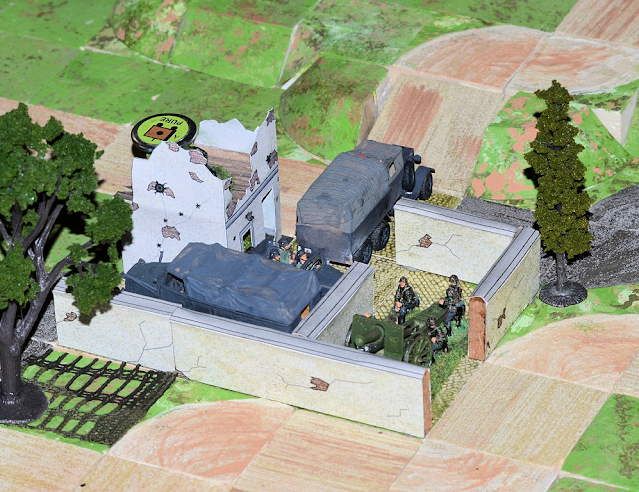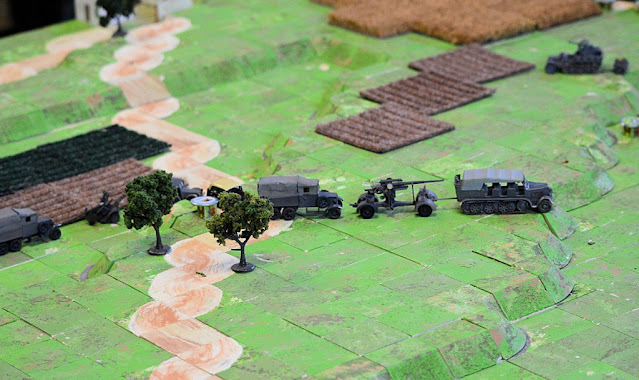A Very Different Tank Battle
Hoogvliet, Netherlands, 13 May 1940
Germans attack to seize the oil tanks at BPM Pernis
The oil refinery and tanks at Pernis, just to the west of Rotterdam, were part of one of the largest complexes in Europe. They were the destination for ships from the oilfields in Dutch East Indies and were a high-priority target for the Germans when they invaded The Netherlands. They were also a high-priority target for the British, as they had identified in their pre-war planning that Germany's shortage of oil would be a targetable vulnerability. Hence, when the Germans invaded The Netherlands, one of the tasks was to seize the plant at Pernis and the British, for their part, were determined to destroy the plant if The Netherlands looked like falling.
The oil tanks and refinery at Pernis were on a peninsula, as they still are today.
The Dutch start astride the peninsula while the Germans will attack from the southeast. Should the British engineers arrive, they will enter from the north and cross the Nieuwe Maas. The Germans have to defeat the Dutch and occupy the facility to pre-empt the British.
The refinery and oil tanks make for some interesting and unusual scenery. This a view of the complex looking north.
The refinery building borders the Neiuwe Maas River. The model is by Walthers as is the piping.

The generator is also a Walthers model.
The oil tanks are cut from an old cardboard roll I had. The transfers came from the Walthers kits. The oil loading platform is also a Walthers kit. The ships are all paper ships from Fentons Paper Models. The railway stock is from Paper Models. Note that the scale of these items is consciously all over the place: the railway stock is 1:100, the ships are 1:250, the refinery is 1:87. The rules used are Command Decision which uses a ground scale of 1:2000. What I am after here is the 'feel' rather than strict scale relationship.
After what is fairly impressive and unusual scenery, the troops are quite ordinary. The Germans are a standard reinforced infantry company from II Battalion, 73rd Infantry Regiment, 46th Infantry Division. They are Veteran, Morale 9. The battalion commander is present, as is an 81mm mortar and MMG. Note the extra stands so that the key weapons can be depicted either moving or deployed to fire.
The Dutch are a Trained, Morale 7 Infantry Company. The British sappers will enter on turn 10.
The Dutch deploy across the neck of the peninsula, with their MMG on the corner closest to the Germans and their command stand in depth.
The Germans deploy just north of Hoogvleit with their Battalion command stand controlling the mortar and MMG, and two infantry platoons.
The company commander and one other platoon are astride the railway line.
An overhead shot showing the relationship between teh two forces at the start of the game.
On the first turn the Germans move to within 12" of the MMG stand. The MMG doesn't fire but still has to check for morale. Given how precarious the Dutch morale is, on the second turn the MMG does fire, despite being Suppressed by the mortar. Being only Trained troops, the MMG only manages to send back the company minus on the railway axis before being destroyed by a hail of fire from the Germans.
Turn 3 and two Dutch platoons are forced back.
The forward Dutch position folds fairly quickly.
The Dutch make a virtue of necessity and Disengage back amongst the oil tanks to reform.
The Germans follow up cautiously.
The Germans deploy for the attack on the next Dutch defensive line, including pushing their MMG to the flank to fire along the railway line through the line of oil tanks.
The Germans rush the Dutch from two directions.
The Dutch have some minor success, pinning the Company coming straight down the road from the main gate. The Dutch do lose two platoons of their own.
The Dutch pull their remaining platoons back behind the small creek but manage to fire some desultory fire at the pinned Germans. Amazingly, in the morale phase, the Germans are Shaken.
The two Ducth platoons are back on their last delay position. Pinned, and just hanging on.
Some good news at last for the Dutch. On the first possible turn, the British engineers arrive on the far bank of the Neiuwe Maas.
The Germans make a bold decision. Instead of staying to rally the Shaken company, the Battalion commander pushes on with the MMG and an infantry platoon in order to get across to the refinery to forestall the British engineers.
The Company minus is left behind. Will the bold move pay off or will the Germans miss these stands?
The Dutch have to hang on to allow the British engineers time to destroy the refinery.
The British are across the river and start moving through the refinery. They appreciate that they will have to help the Dutch see off the Germans before they can set their demolition charges.
The Germans have now moved through the oil tanks and are in position to clear away the last of the Dutch.
The British engineers move around the refinery, ready to adopt their secondary role as infantry and confront the Germans.
The Germans now have a platoon across the small watercourse. It will have to be removed before the demolition.
The British and Dutch now have the numbers advantage over the Germans, who are now sorely missing the Shaken company that was not rallied.
The Germans do have one important advantage: a stationary MMG. It, and the stationary infantry platoon concentrate their fire against the engineers. Two platoons are blown away and with that the game is over.
A very interesting game in some unusual scenery. With such a small number of stands the game played very quickly: 13 turns in a little over 90 minutes. I hope you enjoyed the scenery and the AAR.






















































































